Cross-sectional assessment of nut consumption and obesity, metabolic syndrome and other cardiometabolic risk factors: the PREDIMED study
Palabras clave :
Materias Investigacion::Ciencias de la Salud::Nutrición y dietética
Materias Investigacion::Ciencias de la Salud::Medicina preventiva
Nut
Obesity
Metabolic syndrome
Risk factors
Cardiovascular diseases
Fecha de publicación :
2013
Editorial :
Public Library of Science
Cita:
Ibarrola-Jurado N, Bullo M, Guasch-Ferre M, Ros E, Martinez-Gonzalez MA, Corella D, et al. Cross-sectional assessment of nut consumption and obesity, metabolic syndrome and other cardiometabolic risk factors: the PREDIMED study. PLoS One 2013;8(2):e57367.
Aparece en las colecciones:
Estadísticas e impacto
0 citas en

0 citas en

Los ítems de Dadun están protegidos por copyright, con todos los derechos reservados, a menos que se indique lo contrario.








